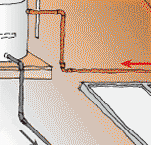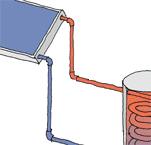Energy
Designing homes to conserve energy and use it efficiently, from sources that cause least environmental harm.
Heat transfer systems
Solar systems offer different options for heat transfer and for circulation of heat exchange fluids.
On this page:
- Heat transfer systems
- Systems for circulating water or heat exchange fluid
Heat transfer systems
The heat transfer in a solar water heating system may be:
- an open loop system
- a closed loop system.
Water circulates using a thermo-siphon or pump system.
Open loop solar water heating system
In an open loop (direct) system, water heated in the collector panels goes back to the cylinder and then to taps and appliances for household use. A system such as a temperature controlled pump to allow hot water to be circulated through the panel on cold nights to prevent freezing must be integrated into the circuit.
Closed loop solar water heating system
In a closed loop (indirect) system, a heat transfer fluid such as glycol circulates through the collector panels, absorbing heat. It carries this heat to a heat exchanger in the hot water cylinder, where the heat is transferred to the water.
Closed loop systems are slightly less efficient than open loop systems as there is some heat loss through the heat exchanger. Their advantage is that they can use a freeze-resistant fluid so are more suitable for frost-prone areas.
For both open and closed loop systems, reduce heat loss between the solar panels and the storage cylinder by:
- keeping the distance between the two as short as possible
- insulating all pipes
- running pipes through warm areas of the house.
Systems for circulating water or heat exchange fluid
Pump system
Pump systems are the type most commonly installed in New Zealand. To optimise performance, a pump controlled by the water temperature can be used to circulate the water/heat exchange fluid. This can:
- provide flexibility in the location of the panel and the cylinder
- increase the form part of the frost protection system by activating a reverse flow through an open loop system when there is risk of frost.
Thermo-siphon system
In a thermo-siphon (or passive) system, as water is heated in the solar panel, it rises by convection into a storage tank located above. Cold water is then drawn into the panel for heating.
This type of system is simple and low-maintenance, and uses no energy, but the cylinder must be located above the solar collectors and the pipes must have a continuous rise. Water flow with a thermo-siphon system is relatively slow. This can significantly increase heat losses from the pipes. See installation for more detail.
Updated: 22 October 2019



